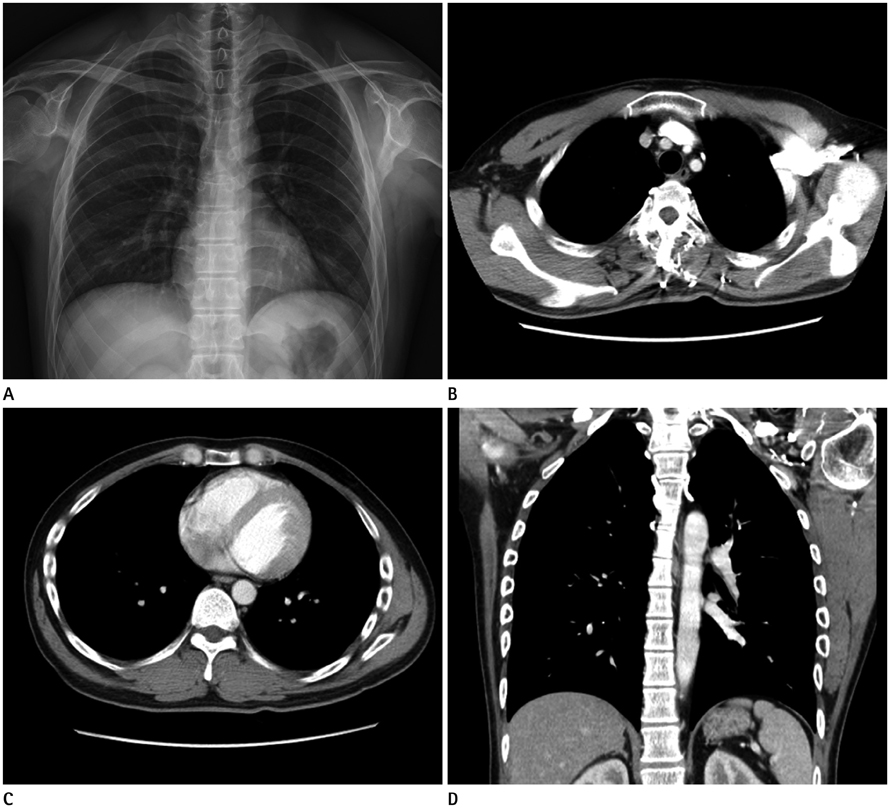J Korean Soc Radiol.
2014 Oct;71(4):178-181. 10.3348/jksr.2014.71.4.178.
Incidental Finding of Unilateral Isolated Aplasia of Serratus Anterior Muscle and Winged Scapula on Chest Radiograph: A Case Report
- Affiliations
-
- 1Department of Radiology, St. Vincent's Hospital, College of Medicine, The Catholic University of Korea, Suwon, Korea. kjminy@gmail.com
- KMID: 2098002
- DOI: http://doi.org/10.3348/jksr.2014.71.4.178
Abstract
- The isolated aplasia of the serratus anterior muscle with winging of scapula is very rare, and only a few cases are reported. Here, we present a case of a 30-year-old Korean male who initially presented with a left flank pain. His physical exam did not show any significant finding in his right shoulder. However, his chest radiograph showed absence of right serratus anterior muscle and slightly elevated and medially rotated right scapula. Subsequent CT scan showed the right serratus anterior muscle aplasia and medial winging of the right scapula. This case is unique in two aspects. First, the combination of abnormalities is different from the typical congenital abnormalities involving shoulder girdle, such as Sprengel deformity or Poland syndrome. Secondly, this was incidentally diagnosed with chest radiograph, without clinical impression. Careful reading of chest radiograph can help the radiologists to detect such clinically silent abnormalities.
MeSH Terms
Figure
Reference
-
1. Martin RM, Fish DE. Scapular winging: anatomical review, diagnosis, and treatments. Curr Rev Musculoskelet Med. 2008; 1:1–11.2. Chernev I, Pessina MA. Unilateral complete congenital serratus anterior muscle aplasia: a case report. PM R. 2009; 1:587–589.3. Levin SE, Trummer MJ. Agenesis of the serratus anterior muscle: a cause of winged scapula. JAMA. 1973; 225:748.4. David TJ, Winter RM. Familial absence of the pectoralis major, serratus anterior, and latissimus dorsi muscles. J Med Genet. 1985; 22:390–392.5. Van Heest AE. Congenital disorders of the hand and upper extremity. Pediatr Clin North Am. 1996; 43:1113–1133.6. Hegde HR, Shokeir MH. Posterior shoulder girdle abnormalities with absence of pectoralis major muscle. Am J Med Genet. 1982; 13:285–293.7. Collins JD. Congenital and acquired atrophy of the shoulder girdle muscles in a patient with Sprengel's deformity. J Natl Med Assoc. 2011; 103:635–643.8. Gonen E, Simsek U, Solak S, Bektaser B, Ates Y, Aydin E. Long-Term Results of Modified Green Method in Sprengel's Deformity. J Child Orthop. 2010; 4:309–314.9. Cavendish ME. Congenital elevation of the scapula. J Bone Joint Surg Br. 1972; 54:395–408.
- Full Text Links
- Actions
-
Cited
- CITED
-
- Close
- Share
- Similar articles
-
- Operative Treatment of Winged Scapula: A Report of 2 Cases
- Pectoralis Major Tendon Transfer for Refractory Winged Scapula: A Case Report
- Treatment of Scapula Fractures of the Inferior Angle Causing Pseudowinging Scapula
- Bilateral Serratus Anterior Paralysis with It's Surgical Treatment: A case report
- Traumatic Winging of the Scapula Treated By Whitman's Technique: Case Report


